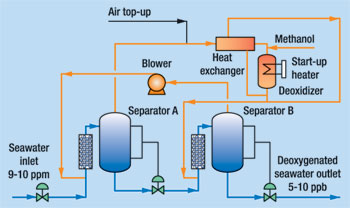Kjell Skar, Managing Director, Minox Technology AS The Minox process, developed during 1985 – 90 by Minox and Norsk Hydro’s Porsgrunn Research Center, is based on stripping oxygen from seawater in a two-stage operation that circulates nitrogen gas. A key process feature is the method of contacting the nitrogen stream with the incoming seawater. By doing this in static mixers, co-current turbulent flow is achieved, producing highly efficient mixing of liquid and gas and simultaneous stripping of the dissolved oxygen from the seawater to very low concentrations. The resulting gas phase contains both nitrogen and oxygen. These are separated from the deoxygenated seawater in separators, the seawater passing directly to the Stage 2 mixer, while the gases are recycled for oxygen removal. This is achieved by reacting oxygen with methanol vapor at 180 – 230°C in a catalytic bed, converting the oxygen to water vapor. The small portion of the circulating nitrogen stream absorbed into the seawater during the stripping process is made up from air, its oxygen content also being removed in the catalytic stage. For startup, bulk nitrogen can be supplied from an external supply, but the principal method is to produce nitrogen from air. With cold starts from air, target oxygen removal is achieved in about one hour.
In addition to the obvious attractions of weight and space saving, the process offers a number of other benefits. Although compact, it is also flexible in terms of equipment design. There are no large equipment items. Hence, the plant can be skid-mounted or stacked, while the separators can be horizontal or vertical. All of which means that each unit can be tailor-made to slot into a given space. This is a particularly attractive advantage when considering installation on existing platforms, where interest is being shown for upgrading conventional de-aeration systems. In such cases, the process will not only enable injection water volumes to be increased with a reduced oxygen content, but the need for a chemical scavenger is eliminated, as well as saving natural gas used for stripping. Another positive feature of the system is elimination of the traditional booster pumps upstream of the main injection pumps. The net positive suction head – following the second separation stage – is sufficient to feed the injection pumps directly, a situation not possible after a vacuum de-aeration tower. Further, if required, the system is capable of operating without an initial fine-filtration stage. The catalyst, in the form of palladium pellets on an aluminum-oxide core is guaranteed to last six years, but has proven to last longer if recommended maintenance procedure is followed. Chlorine is normally added to the water at the platform’s seawater intake for bacterial control and is unaffected by the oxygen removal process. As the catalyst is immune to chlorine poisoning above 160°C, problems have not been seen in the 10 plants currently in operation. Plant buildup. Normally, a two-stage system is used to lower oxygen content to 10 ppb or lower. In the first stage, raw water is introduced at a pressure from 2.5 – 6 barg. The overall pressure drop across the two stages is < 1 barg. The purified nitrogen is divided into two parallel flows, for the first and second stage, respectively. Gas volume can be controlled to obtain the required residual oxygen content. No chemical scavenger is needed. The main system components are:
Example installations. The de-oxygenation technology is delivered and incorporated into seawater injection systems in many of the largest oil producing regions of the world. Some 20 systems have been sold and delivered. The first installation of a 375,000-bwpd unit was delivered to the North Sea Snorre TLP platform in 1991, and the last delivered project, a 220,000 bwpd unit, to BP’s North Sea water injection platform at Valhall. Currently under construction are: Bijupira Salema for Brazil, a 100,000 bwpd unit; Bonga for Shell Nigeria, a 400,000 bwpd unit; and Heidrun for Statoil in the North Sea, a 200,000 bwpd unit. |
|||||||||||||
- Advancing offshore decarbonization through electrification of FPSOs (March 2024)
- Subsea technology- Corrosion monitoring: From failure to success (February 2024)
- Driving MPD adoption with performance-enhancing technologies (January 2024)
- Digital transformation: A breakthrough year for digitalization in the offshore sector (January 2024)
- Offshore technology: Platform design: Is the next generation of offshore platforms changing offshore energy? (December 2023)
- 2024: A policy crossroads for American offshore energy (December 2023)
- Applying ultra-deep LWD resistivity technology successfully in a SAGD operation (May 2019)
- Adoption of wireless intelligent completions advances (May 2019)
- Majors double down as takeaway crunch eases (April 2019)
- What’s new in well logging and formation evaluation (April 2019)
- Qualification of a 20,000-psi subsea BOP: A collaborative approach (February 2019)
- ConocoPhillips’ Greg Leveille sees rapid trajectory of technical advancement continuing (February 2019)




